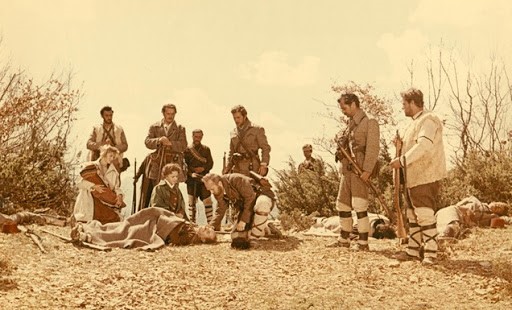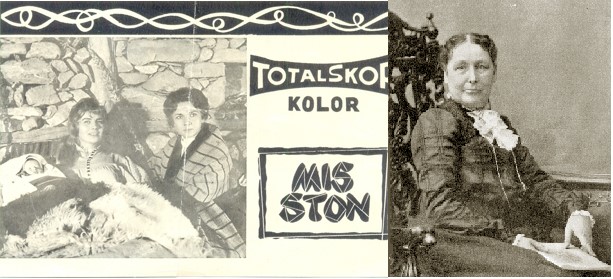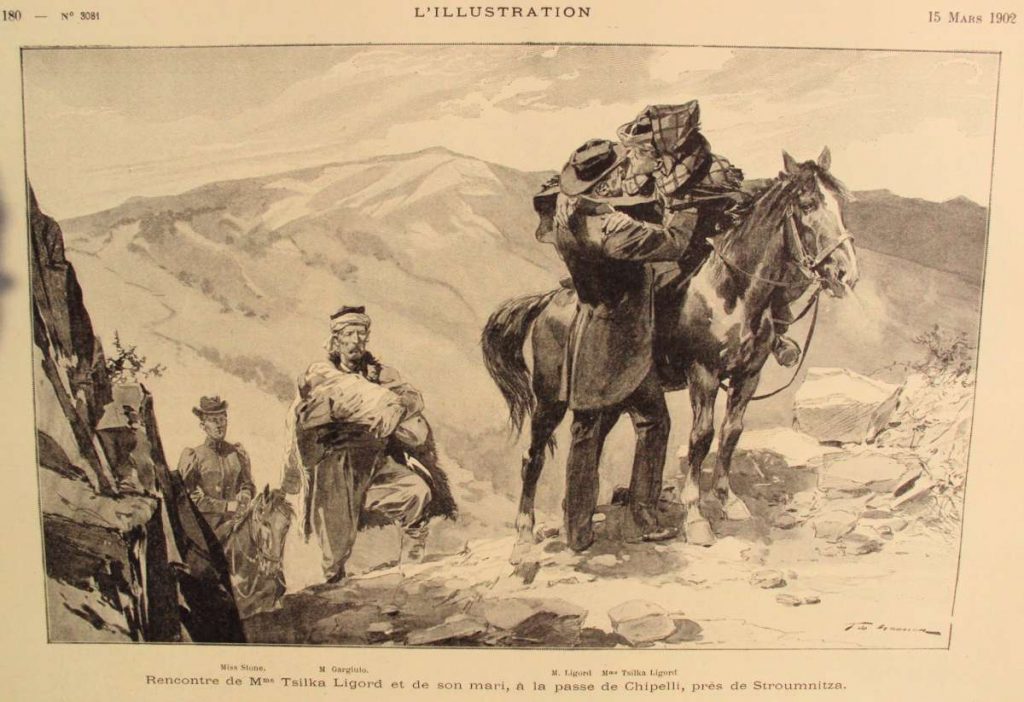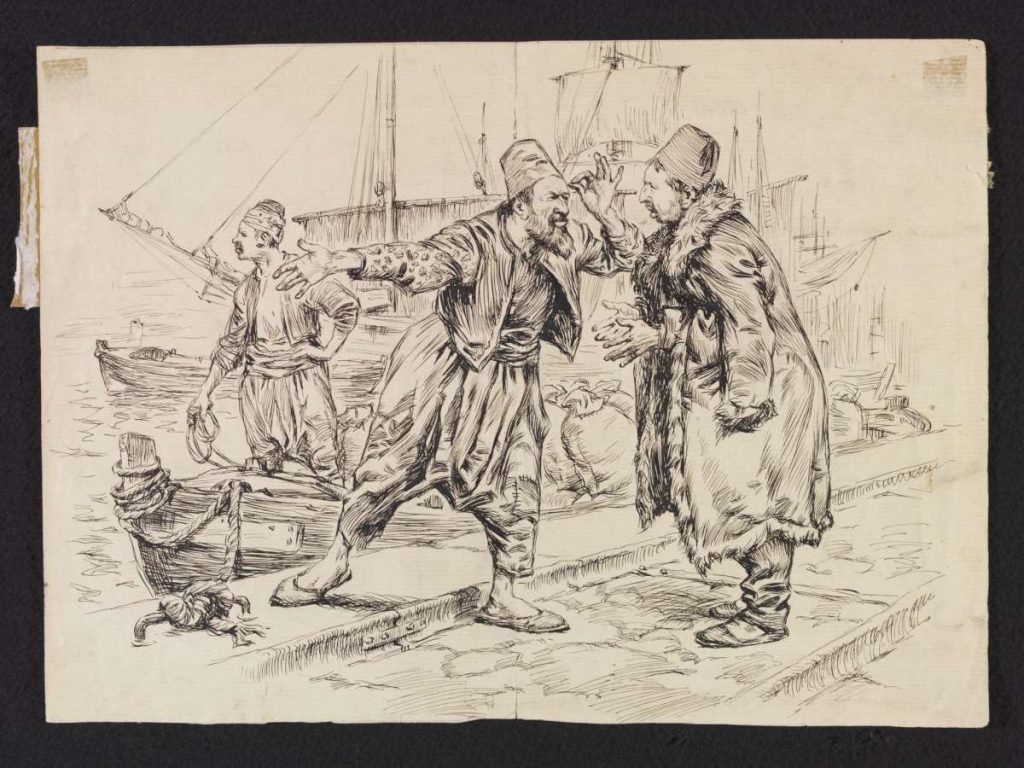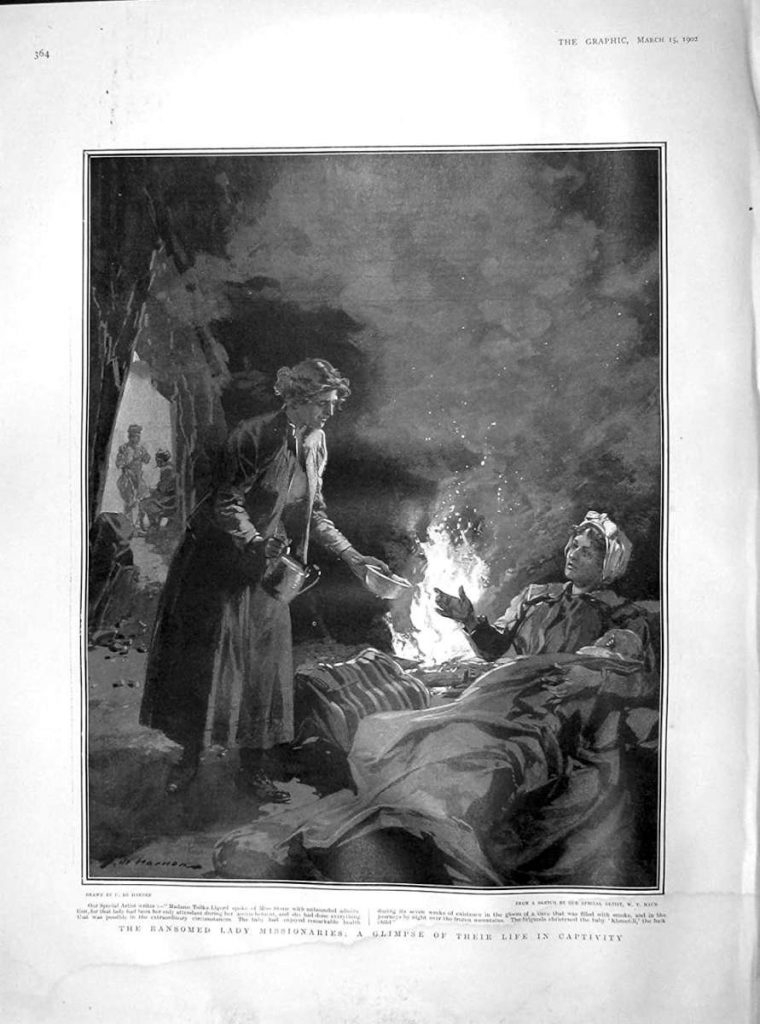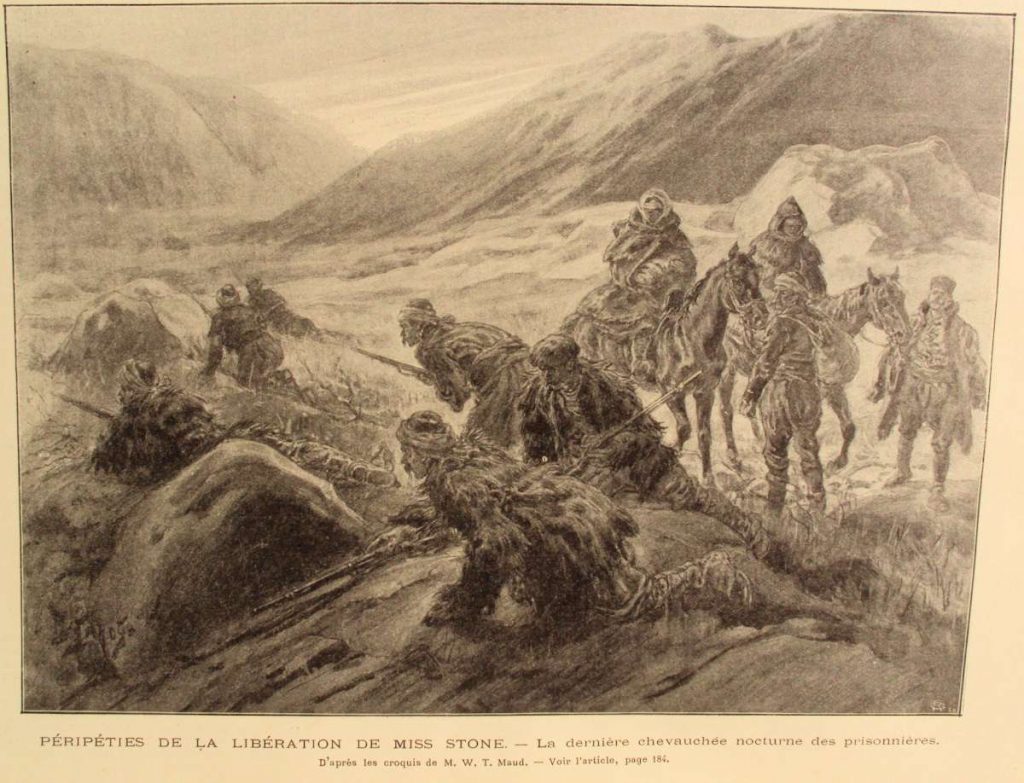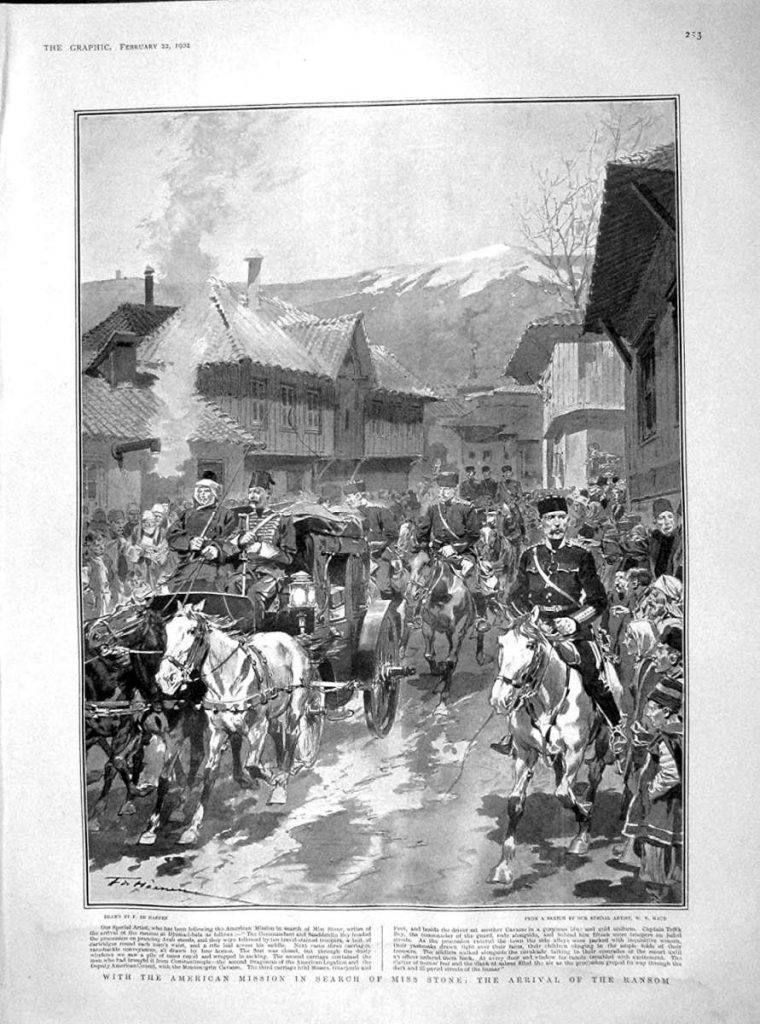1958 – A historic year for Macedonian cinematography
“Miss Stone” – the first Macedonian and Yugoslavian color film, shot in then-advanced “Totalscope” optical technology started to play in Macedonian cinemas. The film tells a story of almost forgotten “breaking news” from the very beginning of the 20th century: in September 1901, the American Methodist missionary Ellen Stone and her pregnant fellow missionary friend Mrs Katerina Tsilka were kidnapped in Ottoman Macedonia by the rebel group of Yane Sandanski and released (together with the newborn baby) in February 1902 after a ransom of 14000 Turkish gold lira’s had been paid. The film plot focuses on the bonding between kidnapers and kidnapped (being the first case of Stockholm syndrome) after the kidnapped ladies witness series of atrocities committed by Ottomans, and series of braveries displayed by the rebels.
The film makers took a great risk. In its time “Miss Stone” was one of the most expensive and most ambitious Yugoslav productions. It was the first Macedonian costume film (costume designed by Milica Babić-Jovanović). The directing (Žika Mitrović), cinematography (Miša Stojanović and Ljube Petkovski) the scenario (Vasilie Popović -Cico) and the music score (Ivan Rupnik) were inspired by Hollywood Western films.
The risk has paid off. The film was an instant hit. The audience adored the film. The children were laughing at the jokes and the goofs of a Charlie Chaplin-like grandpa rebel called “Mandana” (acted by Petre Prlichko). The scene of Mandana baptizing the new born baby remains to be the most charming scene of Macedonian cinematography (https://youtu.be/DIVuWVU3ie4) . The men were feeling their instinct to protect these two helpless beautiful foreign ladies (acted by Olga Spiridonović and Marija Tocinoski) lost in the wilderness of the Wild East. The women were sighing romantically when they looked at the young and brave rebels (acted by Ilija Milchin, Darko Dameski among others) with rough faces and knight hearts. The film transformed the Miss Stone affair as one of the most romantic episodes of history of Macedonia.
The real story was far less romantic.
It is summer of 1901. Тhe Macedonian rebel organization is in a desperate need of money for armaments. Kidnapping оf wealthy important people for a ransom is widespread in the territory of Macedonia and has been practiced by various ethnic groups for various purposes. Gotze Delchev (the leader of the organization) himself already attempted two kidnappings: a wealthy Greek and a wealthy Turk. But the actions were performed sloppy and the kidnapped managed to escape without the ransom being paid. The rebel organization leadership is brainstorming on which important and wealthy person should be kidnapped next. The ideas put on the table by Yane Sandanski were bombastic: kidnapping king Ferdinand of Bulgaria during his visit of Rila Monastery, or the son of Bulgarian prime minister Ivan Estratiev Geshov, or Sulleyman Bey – son od Turkish pasha from Dzumaya. All these plans were rejected by Delchev. The final target was selected: the American protestant Christian missionary Miss Ellen Maria Stone located in Bansko. The kidnapping happened on August 21 1901, on the road from Rila to Pirin mountains while the missionaries travelled from Bansko to Upper Dzumaya. The kidnapping was conducted by the groups of rebel leaders Yane Sandanski and Hristo Chernopeev.
The film alters many historical details. Stefan Mandalov (11.12.1875-03.09.1903) – the real “Mandana” was in fact a 26 years old young man who directly participated in the action. In the “Miss Stone” film, he died saving the lives of the two women and inspiring the film audience, while in reality, he died 1,5 year later in September 1903 after the Ilinden uprising. During the kidnapping, Yane Sandanski has twisted his ankle and he could not step on his food for the next three months. Miss Stone was permanently complaining against the constant smoking by the rebels. Miss Stone also seized this opportunity and persistently tried to convert the rebels to the Bible and Protestantism, something that highly irritated the rebels. The New York Times article from 13 December 1901 notes that “It seems that the rebels are now complaining that Miss Stone wants to convert them” . As the affair started to drag-on, the rebels started to get desperate and nervous. At one moment, the rebels considered options to end the affair, where Hristo Chernopeev was in favor of murdering the women, while Yane Sandanski was strongly against that idea.
For the world’s media “Miss Stone Affair” was the first modern time “Breaking News” and America’s first hostage crisis. And each “Breaking News”, no matter when it happened, brings caravans of news reporters on the spot of the event.
One of them was the “star” of the British war zone reporting: William T. Maud (1865-1903).
William Theobald Maud was educated at the Royal Art Academy in London. As a professional painter, he was not particularly famous or successful. However, we saw his opportunity in the career of war painting.
With the massive growth in literacy throughout the British Empire, coupled with the development of the global telegraph network, the illustrated news weekly flourished. Newspapers sent special war artists to the battlefields to create pictorial records of specific battles, as well as to sketch images depicting everyday life for soldiers on the front line. Many artists of this era took this dangerous assignment for the simple reason that it was more lucrative than painting in a commercial studio. The war artists were untrained for the battlefield, but by virtue of their vocation they were placed in the middle of the action, exposing them to the risk of injury, capture and disease. With pencils, brushes and sketchbooks their job was to go wherever the winds of combat blew, to live under fire, to endure the deprivation, hardship and danger of the campaign, and to send тheir rough and hasty sketches to the illustrated newspapers that employed them.
William T. Maud took this challenge and step by step started to build his career of an elite British war zone painter and reporter. He started to work for the British Illustrated magazine “Graphic and Daily Graphic” in 1895 and travelled to Turkish Armenia in his first mission to draw and report about the massacres. In 1896, he travelled to Cuba to report about Cuban Revolution. His first visit to Macedonia was in 1897 when he joined the Greek army in Thessaly. The year after he reported from the war zone in Soudan. Then from Egypt he travelled to India, and watched the North-West Frontier campaign, and then back to Egypt to chronicle events at Omdurman. He went out to South Africa on the outbreak of war and was shut up in Ladysmith. After a time, he volunteered for active service, and General Sir Ian Hamilton gave him a commission as Lieutenant. He was invalided home with enteric fever, but was soon abroad again, proceeding to Macedonia in search of Miss Stone, the American missionary.
He arrived in Macedonia in January 1902. The “Miss Stone Affair” was major media news, and he saw his opportunity for a reporter’s fame and glory. His ambition was to elevate the world attention to the affair and win an exclusivity of the story from Miss Stone.
By the time of his arrival, the world’s interest in Miss Stone affair started to pale. The affair already took 4 months with no sign of closure. William T. Mode met Miss Stone and Katerina Tsilka in January, and he started to produce exciting drawings from the daily fights and runs of the rebels which were published by the leading European and American newspapers.
The drama and the suspense of William T. Maud illustration brought the public interest back. The “Affair” is back on the newspaper front covers. The world’s pressure to save the missionary women started to mount. Ottoman empire agrees to pay the ransom of 14000 golden lira’s – with a twist. The ransom was a bate with which the Turkish army hoped to attract and capture the rebels. William T. Maud “smelled” a story and drama in this plan. He decided to follow the ransom caravan and wait for the final battle.
There, he made a great tactical mistake.
There was no “final battle”. The rebels have outsmarted the Turks and managed to escape with the treasure. In the meantime, the owner of the American illustrated magazine “McClure’s Magazine”, Mr, Sam McClure arrived in person in Macedonia and manages to obtain exclusivity on the story from Miss Stone in exchange for 5000 dollars. Miss Stone, Mrs Tsilka and her baby are freed, but they did not give any interview to anyone, the whole story went only to McClure’s Magazine.
William T. Maud left Macedonia empty handed onto his next adventure. He went directly to South Africa to report from the Second Boer War (1899-1902) and then followed the British expedition to the Gulf of Aden British Somaliland where new fighting erupted. He died there from a heart attack at the beginning of 1903.
The Aftermath
Upon return to USA, the media interest in Miss Stone was gigantic. The American publisher, major G.P. Pond saw an opportunity for a commercial success, He paid Miss Stone 29 000 dollars to hold 54 lectures across USA and tells her story. The tour was a total fiasco. The first lecture was on 15 April 1902 in her hometown. The audience and the press expected to hear stories of godless Balkan savages which performed all sort of cruelties during her captivity. Instead she was telling stories about brave gentlemen not being afraid to give their lives for a freedom. She started to speak about Turkish atrocities in Macedonia and lobby about the liberation of the province. This open propagation for Free Macedonia has put the American diplomacy in difficult situation with its Balkan ally – Turkey. The US officials have warned Miss Stone to tone-down her critics to Turkey in the next lectures. The US media have abruptly removed Miss Stone from front pages.
Miss Stone died in his home on 13 December 1927. Mrs Katerina Tzilka went back to her family in Albania and died in Tirana in 1952. Both outlived all their Macedonian kidnappers, young people born in the 1880eis and died in the battles against the Ottomans or later in the First World war.
The Macedonian rebels never planned for such huge media attention and impact. They were into this just for the money. Suddenly, they realized the power of the press. The liberation of Macedonia can be achieved only with large and positive world press campaign. Frustrated from being portraited as savages, they started to plan the next media stunt – an action that will shock and capture the Western interest even more. That action was executed on 27th April 1903: assassination of the French steamboat Guadalquivir, blowing up the Ottoman Bank and setting bombs in various cafe’s in Thessaloniki.
The “Miss Stone Affair” and the “Thessaloniki assassination campaign” were major transnational media events by sensationalist covering contributed to the consolidation of rather negative image from the Balkans in the West, which continues to live in some circles until today.
In 1962 a big flood hit Skopje and a large part of the materials in Vardar Film were destroyed which ended the international distribution of “Miss Stone” movie. A protected copy has been made from multiple different copies but a digital restoration of the “Miss Stone” has not been done yet.
The information and pictures in this story are taken from:
- Nada Boshkovska, History Department at the University of Zurich “The Kidnapping of Miss Stone as a Media Event” https://www.academia.edu/
- Wikipedia, Miss Stone Affair https://en.wikipedia.org
- Victoria & Albert Museum, London, Drawing of W.T. Maud http://collections.vam.ac.uk
- Rebels with great heart, the story of real Mandana https://denesen.mk
- William T. Maud biography from Anglo Boer War blog https://www.angloboerwar.com
- Macedonian Film Information Center – Miss Stone (1958) https://web.archive.org
